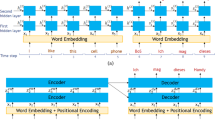Abstract:
This paper presents an analysis of an original hierarchical neural model on a complex sequence - the complete sixteenth fourpart fugue in G minor of the Well-Tempered Clavier (vol 1) of J. S. Bach. The model makes an effective use of context information, through its hierarchical topology and embedded time integrators, and that enables it to keep a very good account of past events. The model performs sequence classification and discrimination efficiently. It has application in domains which require pattern recognition, or particulary, which demand recognising either a set if sequences of vectors in time, or sub-sequences into a unique and large sequence of vectors in time.
Similar content being viewed by others
Author information
Authors and Affiliations
Additional information
Received: 16 March 1999, Received in revised form: 30 July 1999, Accepted: 27 September 1999
Rights and permissions
About this article
Cite this article
Carpinteiro, O. A Hierarchical Self-orginising Map Model for Sequence Recognition. Pattern Analysis & Applications 3, 279–287 (2000). https://doi.org/10.1007/s100440070012
Issue Date:
DOI: https://doi.org/10.1007/s100440070012




